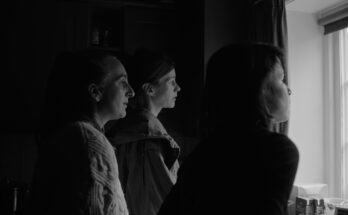Want to hear more from the actors and creators of your favorite shows and films? Subscribe to The Cinema Spot on YouTube for all of our upcoming interviews!
Joseph Konsinski can be described as a modern-day blockbuster director akin to Paul Greengrass, Jon Turteltaub, and even Steven Soderbergh at the height of 2000s cinema. His follow-up to the legacy sequel Top Gun: Maverick, F1, is one of the best films of this year. Co-written with Ehren Kruger, F1‘s biggest and best moments are thoroughly felt while seated in a crowded theatre. The audience very much feels a part of the action and the racing, with the sound design, the editing, and the cinematography all in perfect sync.
Flashes of Failing Greatness to Return
F1 features some of the year’s best uses of the flashback technique. Its first moments are of the career-ending crash that the film’s protagonist, Sonny Hayes (Brad Pitt), suffered at the 1990 Spanish Grand Prix. The film then cuts to our current moment in time—24 Hours of Daytona—, wherein Hayes is now a nomadic racer for hire. From his first moments, one can really sense his need for the pavement, and to win, nothing more. Afterwards, his old and much more successful friend in Formula 1, Ruben Cervantes (Javier Bardem), greets him with a lifeline. That is, a chance to truly be the absolute best in the world: a shot back in Formula 1.
What does it mean to be the best? To accomplish what few others can? At least in Formula 1, to win is to be the best in motorsports, many would say. Yet, what is it really about? Perhaps it’s just about the rush, the pursuit of greatness, rather than the act and the accomplishment alone. The same can be said for filmmaking. A film is not truly great until witnessed by the mass audience. Formula 1 is the pinnacle of motorsports, as filmmaking is to the art of photography. The chase often feels greater than the final element itself.
Almost One and the Same
F1 pursues this same conversation. Is it better to be great for a lifetime, for a moment, or for oneself? The film’s secondary protagonist, rookie phenom Joshua Pearce (Damson Idris), is perfectly juxtaposed with Hayes. Pearce seeks to be the best almost from the start. However, at least in how the script lays it out, it’s not that simple in Formula 1. A driver’s career can be over within an instant. Hayes hasn’t raced in Formula 1 in thirty years, and Pearce is just getting started. It’s as if they both have one last shot to prove themselves, or it’s all over. This is when the screenplay operates at its best, and the drivers constantly improve.
Just when things feel as if they’re about to go in the perfect direction, inevitably, something goes the opposite way. During the Italian Grand Prix, Pearce crashes after ignoring Hayes’s advice and is forced to miss the next few races. However, much of Pearce’s work truly sinks in here, and his comeback feels more serious than anything he’s attempted prior. Before the final race of the season, the Abu Dhabi Grand Prix, Pearce and Hayes seemingly come to terms with their positions both in life and in Formula 1, and finally accept what is. They win simply because there was no other way.
Technical Elements
Kosinski and Kruger’s screenplay often touches the clichés of racing films, but it doesn’t really boil the film down all that much. Where the script falls short, the actual execution of the film maintains the intensity of real Formula 1 races.
Director of photography Claudio Miranda’s cinematography is some of the year’s most high-paced, at times placing the frame literally in front of the car as it moves down the track. Music composer Hans Zimmer’s (Thelma & Louise, Gladiator, Inception, Interstellar, Blade Runner 2049, Top Gun: Maverick, Twilight of the Gods, Eden) score is on par with his best work with Christopher Nolan and adds to the chaos of the racing. Furthermore, editor Stephen Mirrione’s assemblage of cuts, primarily on display during a montage of racing and training, keeps the audience engaged in the best way. The film’s sound design, especially in a Dolby Theatre, bleeds into the audience’s bones and makes it feel like the screen is on display at an actual race.
Final Thoughts on F1
Joseph Kosinski and Ehren Kruger’s F1 continues to popularize the intensity of Formula 1. Like its protagonists, the film wins because it has no other option. F1 prioritizes the need to be seen on the big screen, much in the same way that its sound design needs to be felt and the drivers need to win. What will we do for greatness? Is it really about greatness, or simply the pursuit of it itself? There is an argument for greatness in everything we do, even the littlest of moments. For Hayes and Pearce, or like the actors themselves, do we find greatness in the moment, or grab every moment at the peak of our power?
4.5/5 stars.
Joseph Kosinski’s F1 is now playing in theatres!
For more action and drama-related news and reviews, follow The Cinema Spot on Facebook, Twitter, Instagram, and Bluesky! Also, follow us on Letterboxd for further feature film, short film, and limited series reviews!
Lead Critic for the site, as well as serving as an editor when needed.



